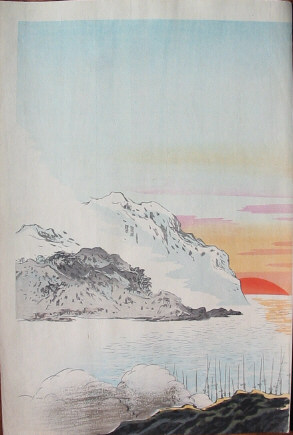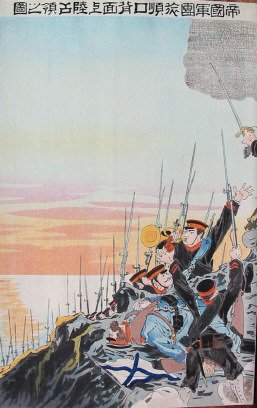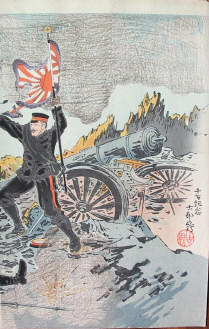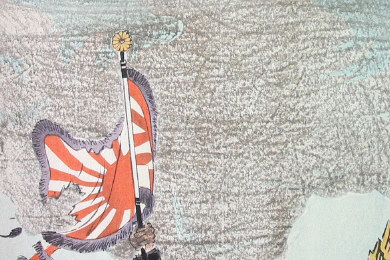
JAPANESE PRINTS
A MILLION QUESTIONS
TWO MILLION MYSTERIES
Ukiyo-e Prints浮世絵版画 |
|
Port Townsend, Washington |
|
OHARA KOSON |
||
|
小原古邨 |
||
|
おはらこそん |
||
|
1877-1945 |
||
|
Russo-Japanese War Triptych |
||
|
"Picture of the Imperial army Landing from the Rear and Capturing Port Arthur" |
||
|
Date: 1905 |
||
|
Signed: Senko Kinen Koson e (In Commemoration for Eternity, Picture by Koson) |
||
| Size: each sheet is 14 13/16" x 10" | ||
|
|
SOLD! |
|
Illustrated: Crows, Cranes & Camellias - The Natural World of Ohara Koson 1877-1945 Japanese Prints From the Jan Perrée Collection, by Amy Newland Reigle, Jan Perrée and Robert Schaap, by Hotei Publishing, Leiden, 2001, p. 195. |
 |
 |
 |
|
T.R. A MAN WITH A MIGHTY BIG STICK |
|
|
|
Anyone familiar with modern military, American, Japanese or Russian history know the significance of the Russo-Japanese War and the part played by President Theodore Roosevelt in brokering a peace treaty between the combatants. In fact, sometime during my high school years I was tested on the Treaty of Portsmouth. Hope I got it right.
However, not everybody is a history buff and for those of you who don't know --- or probably care --- T.R. won the Nobel Peace Prize in 1908 for his part in bringing these two parties together. In his acceptance speech in Oslo Roosevelt said:
"There is at least as much need to curb the cruel greed and arrogance of part of the world of capital, to curb the cruel greed and violence of part of the world of labor, as to check a cruel and unhealthy militarism in international relationships."
"Peace is generally good in itself, but it is never the highest good unless it comes as the handmaid of righteousness..."
"We despise and abhor the bully, the brawler, the oppressor, whether in private or public life, but we despise no less the coward and the voluptuary." |
|
|
|
|
 |
|
THE PRICING OF THIS TRIPTYCH: My Apologia, But Not My Apologies |
||
|
Many factors go into the pricing of a print being offered by anyone anywhere: rarity, condition, popularity, etc. Those of you who are familiar with Sino-Japanese or Russo-Japanese war triptychs know that by and large they are rather inexpensive. There are a few exceptions, but not many. Over the years I have looked at stacks and stacks of such prints. In fact, the day I found this one it was in the middle of a pile of similar items. It had been purchased as just one triptych in a large bunch. Initially, I was drawn to the beautiful nature of the lightly colored gray baren work of the smoky cloud in the upper right. It took my breath away. I didn't even notice who the artist was. That came later and was quite a surprise.
I had sold many kacho-e, i.e., bird and flower prints, by Koson, a name in his early artistic career, and Shoson, his last incarnation. I had never seen anything like this --- not even an approximation. The condition, to boot, was astounding.
Roger Keyes, noted in a paper he delivered, that some prints were printed with faint colors. This may have been a cost saver, he added. However, in this case, the printing was based on aesthetic principles --- much like those to be seen in so many early nineteenth century surimono. Amy Reigle Newland wrote that "Koson produced a handful of ōban triptychs of the Russo-Japanese war." Later she points out that "The artist's training as a Shijō painter is evinced in these war triptychs by the naturalistic treatment of the subject and the subdued palette..." |
||
 |
||
|
Most notable in the detail to the left is the astounding use of the delicate colors --- light gray over light blue in the sky --- and the particularly skillful use of the baren. Contrast this with the solidity of the tattered Japanese flag and it is made clearly that much more remarkable. Even the gray of the smoke is printed over the left hand of the flag bearer. |
||
 HOME
HOME